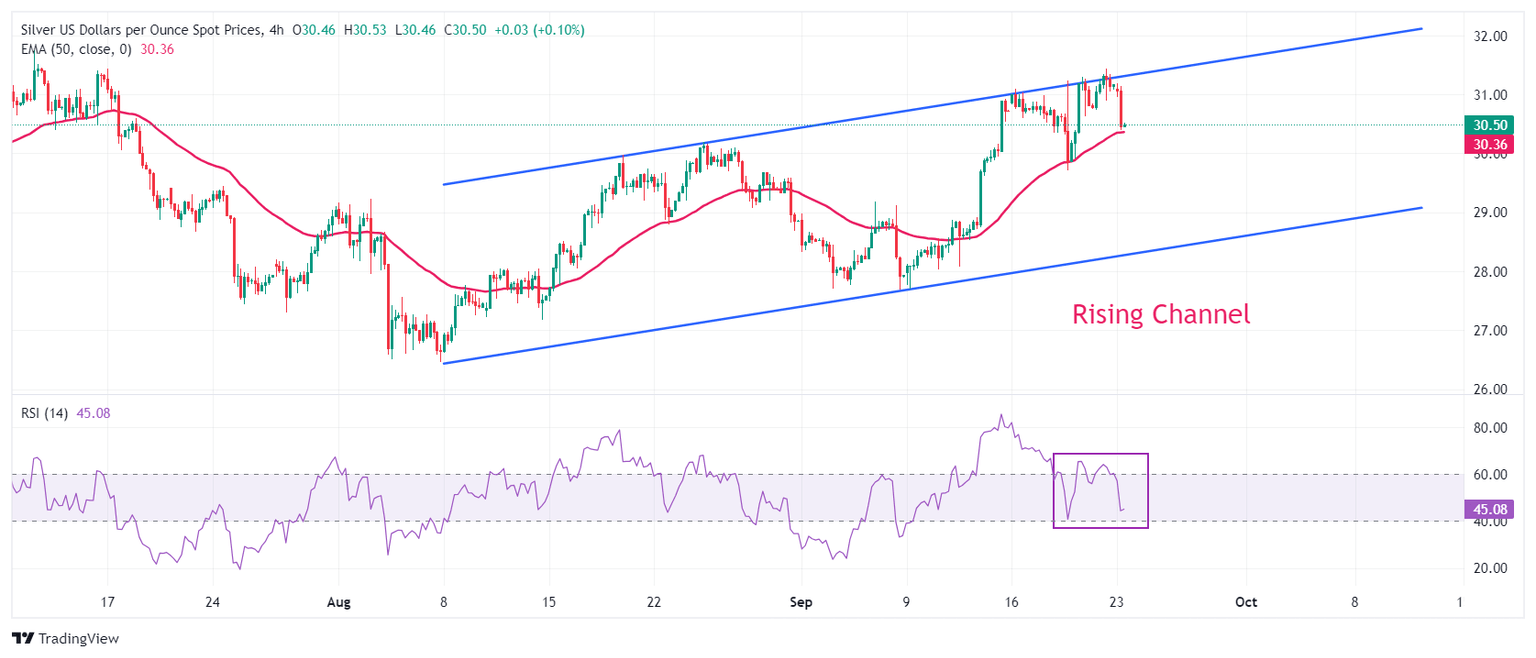Silver Price Forecast: XAG/USD tumbles to near $30.50 as US Dollar gains ground
- Silver price slumps to near $30.50 after a strong recovery in the US Dollar.
- Traders are split over whether the Fed will cut interest rates by 25 or 50 bps in November.
- Investors will focus on the preliminary US PMI for September.

Silver price (XAG/USD) faces sharp selling pressure above the key resistance of $31.00 and drops to near $30.50 in Monday’s European session. The white metal drops sharply as the US Dollar (USD) gains ground even though market speculation for the Federal Reserve (Fed) to opt for a second consecutive interest rate cut by 50 basis points (bps) remains firm.
The US Dollar Index (DXY), which tracks the Greenback’s value against six major currencies, rose swiftly by 0.4% above 101.00. A decent recovery in the Greenback makes investment in precious metals, such as Silver, an expensive bet for investors.
The CME FedWatch tool shows that the probability of the Fed reducing interest rates by 50 bps to 4.25%-4.50% in November is close to 50%. For the remainder of the year, trades have priced in a 75-bps interest rate cut. On the contrary, Fed policymakers see the federal fund rate heading to 4.4% by the year-end.
Going forward, investors will focus on the United States (US) preliminary S&P Global Purchasing Managers’ Index (PMI) data for September, which will be published at 13:45 GMT. Economists estimate the Manufacturing PMI to have improved to 48.5 from 47.9 in August. However, a figure below the 50.0 threshold is considered a contraction. The Services PMI is expected to have expanded at a slower pace of 55.2 from the prior release of 55.7.
Silver technical analysis
Silver price trades in a Rising Channel chart formation, on a four-hour timeframe, in which the upper portion acts as resistance. Each pullback is considered a buying opportunity by market participants.
The white metal has dropped to near the 50-period Exponential Moving Average (EMA) near $30.36, suggesting an uncertainty ahead. However, the upside bias remains intact.
The 14-period Relative Strength Index (RSI) oscillates in the 40.00-60.00 range, suggesting a weakening of momentum.
Silver four-hour chart
(This story was corrected on September 23 at 11:39 GMT to say that the US Services PMI is expected to have expanded at a slower pace of 55.2 from the prior release of 55.7.)
Silver FAQs
Silver is a precious metal highly traded among investors. It has been historically used as a store of value and a medium of exchange. Although less popular than Gold, traders may turn to Silver to diversify their investment portfolio, for its intrinsic value or as a potential hedge during high-inflation periods. Investors can buy physical Silver, in coins or in bars, or trade it through vehicles such as Exchange Traded Funds, which track its price on international markets.
Silver prices can move due to a wide range of factors. Geopolitical instability or fears of a deep recession can make Silver price escalate due to its safe-haven status, although to a lesser extent than Gold's. As a yieldless asset, Silver tends to rise with lower interest rates. Its moves also depend on how the US Dollar (USD) behaves as the asset is priced in dollars (XAG/USD). A strong Dollar tends to keep the price of Silver at bay, whereas a weaker Dollar is likely to propel prices up. Other factors such as investment demand, mining supply – Silver is much more abundant than Gold – and recycling rates can also affect prices.
Silver is widely used in industry, particularly in sectors such as electronics or solar energy, as it has one of the highest electric conductivity of all metals – more than Copper and Gold. A surge in demand can increase prices, while a decline tends to lower them. Dynamics in the US, Chinese and Indian economies can also contribute to price swings: for the US and particularly China, their big industrial sectors use Silver in various processes; in India, consumers’ demand for the precious metal for jewellery also plays a key role in setting prices.
Silver prices tend to follow Gold's moves. When Gold prices rise, Silver typically follows suit, as their status as safe-haven assets is similar. The Gold/Silver ratio, which shows the number of ounces of Silver needed to equal the value of one ounce of Gold, may help to determine the relative valuation between both metals. Some investors may consider a high ratio as an indicator that Silver is undervalued, or Gold is overvalued. On the contrary, a low ratio might suggest that Gold is undervalued relative to Silver.
Author

Sagar Dua
FXStreet
Sagar Dua is associated with the financial markets from his college days. Along with pursuing post-graduation in Commerce in 2014, he started his markets training with chart analysis.


















